
Common Problems
Curly Top Virus
Tomato Horn Worm
Blossom End Rot
Grasshopper Damage
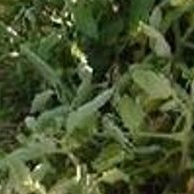
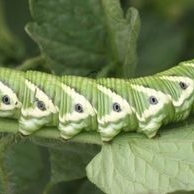
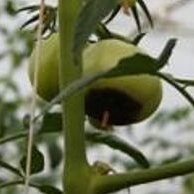
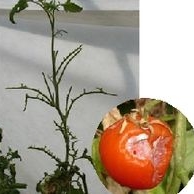
Curly top virus is common in tomatoes, especially in years when there has been a large bloom of mustard weeds. The leaves start to curl up, showing the underside of the leaves, the overall color becomes more yellow, and the veins in the leaf may take on a purple color. There is no cure. The virus is spread by the beet leaf hopper, and when it feeds on the tomato plant it infects the plant. Remove the affected plant to keep from spreading the virus. If still early in the season you can try replanting and still get some tomatoes. While there is no cure you can help prevent infection with weed control. The beet leaf hopper feeds on mustard weed, which was quite prevalent this year. When the weeds die back in late May, the leaf hopper looks for other plants to feed on. Early spring control of weeds will help keep the beet leaf hopper under control.
A tomato hornworm is a destructive larva of the North American hawk moth (Manduca quinquemaculata) that feeds on tomato plants. They feed on the leaves, stems and fruit of all of the night shade family of plants including eggplant. They are difficult to see on the plant. They can be picked off by hand, or sprayed with Bacillus thuringiensis (Bt) which is safe to use on food crops. It will emerge as a moth in June or July, which lays eggs that will hatch in just one week. They overwinter in the soil.
View NMSU Publication on Grasshopper Control

Plant Tomatoes Deep, Deep, Deep
Cover the stem up to the plant’s leaves. You can even cover the first few leaves with soil. Roots will grow along the buried stem to make the plant stronger. Each Bonnie tomato label urges you to plant tomatoes deep, so that a full 2/3 of the plant is underground. That means that if you buy a 10-inch tall plant, all but the top three inches is buried. Why? Because the plant will have a better, stronger root system. Better roots mean better tomatoes.Whether in a pot or in the ground, set each tomato plant so that 2/3 of the plant is buried.We know, we know. This goes against everything you’ve ever heard about “don’t plant too deeply or you’ll kill the plant.” Tomatoes break that rule. They sprout roots along the buried stem. The extra roots strengthen a plant so that it can support more fruit and is better able to survive hot weather. (This applies whether you’re growing in the ground, in a raised bed, or in a container.)In really heavy soil, and that the ground beneath it isn’t hard as a brick. To do this, angle the plant so that the growing tip is above ground. If your soil drains poorly, create a raised bed with potting soil that is piled at least 8 inches above ground level.Once you’ve nearly buried it in soil, only the top few inches of the plant will be exposed. Water well, label the plant (to help you remember which variety you’re growing), and watch your tomato plant grow big and strong. Within a few weeks, your plants with super roots will delight you with a bountiful harvest of lovely fruit. -Info & Photo Courtesy of Bonnie Plants
Great Links For More Info
Tomato tree / Applying manure and compost– Desert Blooms NMSU
What’s Killing My Tomatoes? – Desert Blooms NMSU
Direct Sun Killing Plants | Tomato Problems – Desert Blooms NMSU
Performance of tomato varieties :: NMSU Cooperative Extension …
Tomato – NMSU Cooperative Extension Service and Agricultural …
How to Grow Tomatoes in Pots– BonniePlants.com
How to Support Tomatoes– Cages, Trellis etc.- BonniePlants.com
How to Prune Tomatoes for a Big Harvest – BonniePlants.com


Crop Selection
High Elevations: Select varieties of short season crops Low Elevations: Select varieties for heat tolerance
Determinate vs indeterminate Determinate and indeterminate are terms related to the growth habits of tomatoes. Indeterminates’ are plants that have a vining habit and produce a moderate amount of tomatoes continually throughout the growing season. These are usually referred to as STAKING tomatoes. Determinate plants are more stocky and have one or two full flushes of production, usually resulting in one or two large harvests as opposed to an indeterminates’ smaller but more steady production. Determinates are usually referred to as BUSH tomatoes.
Determinate varieties tend to stay short and relatively bushy. That makes them a good choice for small gardens as well as containers or planters on the back patio or balcony. When using determinates, restart seeds after planting the first set of plants so that when the first set is finished producing tomatoes, plants can be removed and replaced with a new set of plants for another harvest.
At lower elevations you can usually get three rotations in per season.
Example: Start 1st set of seeds in Jan. – plant in March
Start 2nd set of seeds in April – plant in June
Start 3rd set of seeds in June – plant Late July or August
Higher elevations may only get in 2 rotations: start seeds Mid-Feb – plant Mid May
start 2nd set Mid-June – plant August
Indeterminate plants keep growing and need to be staked and tied up to a trellis or other support. You can pinch them back to force more growth below, but it’s just as easy to work with them and tie them up. Indeterminates can get very, very big and rambly, so train them to grow vertically to save space.
There is generally no difference in taste or size of the fruit, as this is more dependent on the variety itself than the growing habit. To grow both types of plants, use the determinates in smaller beds due to their stockier growth habit, and indeterminates in back where they can be trellised
Heirloom vs Hybrid
Heirloom – A old variety which has been maintained either because it has appealing attributes like extra large size, unusual coloring, special connoisseur qualities, or because of family sentimental reasons. Because heirloom tomatoes haven’t been ‘worked on’ by plant breeders, they don’t usually have much disease resistance. Many diseases can be essentially prevented or delayed by mulching the soil surface to prevent disease spores in the soil splashing up and infecting the young plants. Mulching plus fungicidal sprays (if you can be bothered) mean that heirlooms can usually be grown successfully in all but the very hot humid areas notorious for tomato disease
Hybrid – this is a variety created by deliberately and painstakingly taking pollen from an existing open pollinated tomato and putting it onto a different open pollinated tomato. The seed gives a first generation (F1) that are extremely uniform. But keeping seed and resowing it gives a highly varied and non-uniform lot of plants and fruit. The original cross to create the F1 seed has to be done every year. The advantage of hybrids is vigor, and the ability to use a parent known to be disease resistant.
Native Seeds- can also be used to grow vegetables, flowers, trees or shrubs. Besides the expected drought tolerance of desert plants, many of these crops are resistant to rusts, insects, chemicals, and other stresses. They provide an irreplaceable “genetic library” to draw upon to ensure sustainable, environmentally safe agriculture in the future. “’Ancient seeds for modern needs’, is the motto of Native Seeds/SEARCH, a non-profit organization based in Tucson, Arizona. Since 1983 the group has been collecting seeds of food plants used by the native cultures in the arid region of the southwestern US and northwestern Mexico, sometimes referred to as the Chile Pepper Nation. Their mission has led them not only to conserve the rare crops adapted to arid lands, but also to preserve cultural traditions by distributing crops back to Native American communities.”
For more information visit: http://www.nativeseeds.org
Organic Seeds– are also available to the home gardener. Many of the seeds you purchase today may have been genetically modified for disease and pest resistance, increased nutritional content , higher yield. But unlike the traditional hybridizing of plants mentioned above, this modification is done at a genetic level, often splicing genes from unrelated species to gain the desired trait. The mechanical transfer of genetic material outside of natural reproductive methods and between genera, families or kingdoms, may pose biological risks. For example, it’s uncertain what unintended effects transgenes designed to resist pests might have on beneficial insects or how they could upset various balances in nature. The debate is still raging. Genetically modified plants are sometimes described as bioengineered or transgenic. Organic seeds are not genetically engineered, nor are they ever treated with fungicides or pesticides. There are many commercial sources available. (ie: www.seedsofchange.com )


Tomato Varieties
Tomatoes come in a variety of sizes shapes colors and flavors. Some are better suited for eating fresh while other do better in cooked dishes or being canned or frozen.
Listed below is information on many different varieties and their best uses. –Information Courtesy of:http://www.naturalhub.com/grow_vegetable_cultivars_tomato.htm
Images Courtesy of Burpee Seeds Co.
PLUM TOMATOES
BEEFSTEAK TOMATOES
SALAD TOMATOES



-cooking or fresh eating
Plum tomatoes often have fine thick flesh and reduced amounts of pulp. This makes them good for holding shape when canned, and it means they also slice quite well. Because they have less pulp they cook down for sauces faster than some. A good tasting cultivar may be the only tomato you need. It has to be said tho’, buying canned plum tomatoes from the supermarket is often cheaper and definitely easier than growing and canning your own.
Amish Paste Staking variety. ‘plum’ type multi purpose tomato. Because it has few seeds and thick fruit walls it is particularly useful for making sauces or any dish where canned tomatoes are called for. It produces well. A variety maintained for many years solely by the Amish religious sect of USA. Main season.
Costoluto Genovese Staking variety. Rigged, fluted, and lobed, these uneven medium sized tomatoes are vigorous, bear well, but because of their shape are difficult to can/preserve. Like most plum tomatoes, they are otherwise suitable for sauce or fresh eating, altho’ they are too small and uneven to be properly considered a slicer.
-the primo slicer for sandwiches or cooking
Beefsteaks are the very biggest tomatoes. Their pulp cavity is generally relatively small, and always compressed and distorted by the extensive placenta wall, giving the ‘marbled’ appearance of a steak. Because of the compressed pulp cavity and networking of the fruit wall as placenta, beefsteaks hold together well when sliced, and together with their large size, make them the ideal ‘slicer’ for sandwiches. Because of their high fruit wall to pulp ratio, they also cook down well for sauces. There is a lot of variation between varieties in the density of the flesh, it’s juiciness (i.e. firm or very soft when ripe), and in the size and softness of the central ‘core’. Flavor, as always, can vary, according to the ratio of sugars to acids, and according to the relative amount of sugar or acid present.
Big Beef F1 Staking variety. Outstandingly productive, easily out producing most other large, (about 100mm/4 inches in diameter/ 280 gms ) very regular fruit shape, with no cracking, produce large tomatoes even toward the end of the season, very good flavor. One of the very best of the large main season varieties.
Big Rainbow Staking variety. A spectacular looking tomato grown from at least the 1900’s in the USA. Basically a large to very large yellow beefsteak, as the fruits ripen, go through a phase where they resemble a rainbow – ‘greenback’ on the shoulders, yellow in the middle, and with red blushed pink on the blossom end. The early set fruit can be very large at 900grams/2 lbs or more. The flesh is marbled red and orange. It is relatively free of fruit defects, and bears well. Highly rated in taste tests. Main season.
Brandywine Staking variety. A large beefsteak. Not as tall a some staking plants, this old cultivar (pre 1885, from the Amish community in USA) is renowned for its flavor. The fruit are large, between 400 and 700 grams. They are subject to minor cracking on the top, and are a rather soft fruit, but the flavor is outstanding, with both high sweetness and acidity, making for full flavor. The flavor can be poor in unfavorable seasons. Moderately productive. Main season. It has no disease resistance, and is unsuited to very humid hot areas where disease is a problem.
Evergreen Staking variety. Ripens green turning yellow. Medium sized fruit. The solid dense fruits are well suited to salsas, as well as slicing for frying or sandwiches. Main season.
Golianth F1 A large, smooth, deep red skinned commercial variety of around 300gms/10oz or more. Widely adapted and disease resistant. Early mid season.
Giant Belgium Lg to very large, dark pink fruit around 1 lb. The flesh is dense and meaty.
Great White Staking variety. A particularly vigorous beefsteak, bearing large fruit of around 400 gms. The fruit are yellowish white. Main season.
Grosse Lisse Staking variety. Vigorous, adapted to humid areas. Large, (plus 200 grams) heavy yielding cultivar. Moderate sweetness, low to moderate acidity. Main season.
Marvel Striped Staking variety. Grown in Oaxaca, Mexico, at least since the mid-1800’s. The large, heart-shaped fruit are yellow streaked with bright orange. Yellow flesh, streaked pink. The skin is thin. Juicy. The flavor is sweet Vigorous.
Mortgage Lifter Staking variety. Extremely large, furrowed, red beefsteak (up to 1 kilo). In good conditions it can be exceptionally productive. Main season
Pineapple Staking variety. The fruit are yellow-red striped, and the plants have heavy foliage. which helps prevent sunscald.
Ponderosa Pink Staking variety. Large fruit, 200 grams and better. Very ripe fruit are sweet with low acidity. Slightly under ripe fruit are sweet and with better acid. This variety is outstanding for flavor. Main season.
St. Pierre A French heirloom variety actively sought out in the street markets for it’s superior flavor.
Yellow Brandywine– a deep yellow, near orange color ‘sport’ of ‘Brandywine’
-for summer salads, Fresh eating
Seed locule (pulp) tends to fall out if they are sliced. Abundant seed pulp makes them a slow reducer if they are being used for sauces. But their smaller size makes them ideal for cutting in half or in quarters to have with a salad.
Arkansas Traveler This pink fruited heirloom variety from the Ozark Mountains is medium sized, widely adapted and has good flavor.
Burpees Longkeeper Staking variety. A medium to large orangey-red tomato (about 150gms) whose special feature is that if the plant is put in later than the main crop, the Autumn ripening tomatoes will keep for up to three months if care is taken to store only undamaged fruit. Main season, but intended to be delayed, planted to ripen late.
Cherokee Purple A rather short staking variety said to have been grown by the Cherokee tribe of USA at least since the late 1800’s. This is a large (250 grams/9oz or more) dirty pinky-purple colored fruit with brownish shoulders. The flesh is soft, brick colored with green gel. It is one of the sweetest (if not the sweetest) large tomatoes available. It has little acid. Mid season.
Djena Lee’s Golden Girl Developed in Minnesota in the 20’s by one Djena Lee, this deep yellow tomato has a reputation for quite exceptional sugar acid balance and intensity of flavor.
Dr.Walter Staking variety. Productive. Low acid. Main season.
Early girl Staking variety. Starts maturing fruit early and carries on producing to relatively late in the season. Moderate sweetness, medium to high acidity. A good all season tomato for those who prefer the acid notes in tomatoes.
Fourth of July Staking variety. Early season. It has particularly good flavor for an early tomato, and although the first picked tend to be a bit flavorless, the flavor improves as the season warms up. A good choice for cool season and short season areas. The fruit are small, at about 30-40mm/a bit over an inch to about an inch and half.
Gold Dust-an orange skinned version of ‘Taxi’ (see below).
Green Zebra Developed in the mid 80’s by heirloom tomato breeder, Tom Wagner of Tater Mater Seeds. Uniform, small (50mm/2 inch) olive yellow fruit overlaid with dark green stripes. The flesh is green with good sugar acid balance. Productive.
Guernsey Island Staking variety. Medium to small fruit, red streaked with dull bronzy green. Medium acid, low sugar, clean flavor. Guernsey Island has unusual purple red flesh, and is juicy. Main season.
Heatmaster (syn. ‘Sunwave’) Adapted to hot subtropical conditions. This deep red mid season tomato has disease resistance and is medium sized (200gms/7 oz).
India F1 A round red medium-to-small tomato (around 100 grams) that is prolific. Main season.
Jimma F1 Staking variety. A medium sized tomato bred to last for up to a month without rotting once picked. Early season.
Moneymaker Staking variety. Attractive, round, medium sized (about 115 grams) fruit on a vigorous plant better adapted to humid conditions than some. Flavor is good, medium sweetness: low acid when well ripened, and the reverse when just ripe. Main season.
Mr.Stripey-see ‘Tigerella’
Nebraska Wedding Staking variety. Medium sized orange skin and flesh. Late ripening.
Potentate Staking variety. Attractive looking crimson red, round, medium/small (about 75gms) firm tomatoes with moderate acidity and low sugar.
Stupice Semi-determinate. A small-to-medium red salad tomato that has high acid and medium sugar when just ripe, but has mediocre flavor when very ripe. The plants produce early to very early, setting well when others don’t, and are productive and reliable. They dry quite well. The only defects are a little greenback, and the calyx tends to tear out when they are picked (hard to pick).
Taxi Determinate variety. Lemon yellow turning deep yellow with maturity, a round to slightly flattened, medium sized (about 100 gms) dense, firm-fleshed tomato that holds together well when sliced, with a slightly savory, medium acid low sugar taste. Good. Unusually, it has a relatively tender skin. Taxi is quite widely adapted, and performs well even in humid hot areas.
Tigrella Staking variety. Tigerella (syn ‘Mr.Stripey’) is a small fruit with red and orange stripes. It is quite productive, early mid season, with unremarkable mainstream low acid low to moderate sugar taste. The gel is juicy and quite loose in the fruit. The skin is quite tough. Tigerella is attractive, and free of any ‘greenback’ as it ripens.
Yellow Perfection Staking variety, vigorous potato leaf. This is an old English variety with deep golden-yellow skin and golden-yellow flesh. It is said to be thin skinned, with good flavor and is juicy small It is a rather small fruit, at about 30grams/1 oz. Zorba-Introduced by Santa Barbara Heirloom Seedling Nursery in the late ’90’s, this Cretian variety is said to have outstanding flavor.
CHERRY TOMATOES
PASTE/DRYING TOMATOES
HEIRLOOM TOMATOES


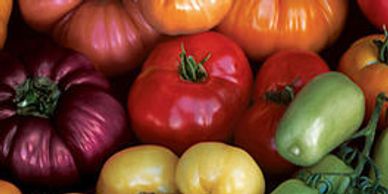
– tiny tomatoes for putting whole in salads, or for snacking
These tomatoes vary from pea sized up to where they tip over into small ‘salad’ type. They are usually very prolific, and some have been bred for high sugars as a snacking ‘fruit’. They are very colorful as a whole tomato in a salad, and their size makes them ideally suited to this purpose.
Cherry Dots-Lycopersicon pimpinellifolium -see ‘currant red’
Currant Red Staking. This is Lycopersicon pimpinellifolium, one of the wild progenitors of the domestic tomato. The vigorous plants produce sprays of pea sized fruit of unremarkable but perfectly acceptable flavor. The smallest tomato available. Main season.
Currant Yellow The yellow form of ‘Currant Red’.
Gardeners Delight Staking variety. This vigorous variety produces trusses of 6-12 sweet small fruit throughout the season. Early season.
Green Grape Looks like a cluster of 4 to 12 large yellow/green grapes, such as the muscat grape. This cross was bred from 4 different heirloom tomatoes, plus ‘Evergreen’ by ‘The Tater Mater Company’ , and released in the mid ’80’s.
Gold Nugget Bush variety. Good rich color in a small (plus 2.5cm diameter) fruit.
Peacevine Vigorous bush – Developed by Alan Kapuler of ‘Seeds of Change’. Said to have a particularly high vitamin C content. 20mm/ 3/4 inch red fruit, productive till quite late in the season.
Red Pear Essentially identical to Yellow Pear, but with some flavor.
Santa F1 Oblong, meaty, very good flavor, highly productive; once picked keep better than many cherry tomatoes.
Spoon Tomato-Lycopersicon pimpinellifolium-see ‘Currant Red’
Sun Cherry F1 Staking variety. There are up to 20 small (30mm diameter) red fruit per long truss on this vigorous plant. Said to be the sweetest cherry tomato. Early season.
Sun Gold Staking variety. A golden yellow cherry tomato with particularly good flavor, almost universally preferred over other cherry tomatoes. Seems to perform well over a range of climatic conditions, including cool early season.
Sweet 100 F1 Staking variety. The plant is vigorous, and spectacularly productive, and reliable. Small (30mm diameter) fruit are born in long herringbone trusses of around 15 fruit. The fruit are sweet, with a little acid. One of the very best in this class. Early season.
Sweet Million F1 Staking variety. Very similar to ‘Sun Cherry’, and like ‘Sun Cherry’ very sweet. Early season.
Tommy Toe Staking variety. A vigorous plant producing small (30mm diameter) bright red tomatoes that have an excellent sugar: acid balance. It also has the virtue of having a long cropping period.
Tumbler F1 Bush variety. Orangey Red fruit, small, about 15 gms. Low sugar, low acid. Productive. Promoted for pot culture.
Yellow Pear Staking. Old variety, from the early 1900’s. Yellow pear shaped small fruit, about 40mm long, borne in clusters. Little flavor, but attractive. Prolific. Main season.
-These have almost no seed locule, so dry or boil down to paste more quickly than all others.
Napoli Bush variety. Compact plants with some root and stem disease resistance, Napoli produces small (80 gm) bright red, pear shaped, solid fruit. It has a very concentrated set, and therefore a concentrated harvest. Main season.
Opalka Staking variety. An heirloom variety which sets fairly good crops of elongated red fruit on a short vine. Unlike most paste tomatoes it has good eating qualities. Main season.
Principe Borghese Bush variety. Small oval red fruit that often contain no seeds at all. Very productive, no flavor as a fresh fruit, very suitable for bottling or drying. Main season.
San Marzano Staking variety. A standard mainstream paste tomato. Deep red, small oval/pear, dry fruit borne in clusters on the vine, for processing. Main season
“Short Season” Buckbee’s New 50 Day Heirloom Tomato – Good yields of great tasting 4 oz. red round fruit. Indeterminate. 55 days
Early Annie Heirloom Tomato – (A short heirloom variety that produces 3-inch, round, meaty fruits with few seeds. Particularly good for canning. Fruit sets all at once. Determinate. 60 days.)
Marmande Heirloom Tomato – French heirloom. Big clusters of 6-ounce, red, slightly lobed & flattened fruits that contain an excellent, complex, flavor. Indeterminate. 67 days
Moskovich Heirloom Tomato – A wonderful, early heirloom tomato that yields an abundance of red, 6 oz., round, cold-tolerant, fruits with a luscious, rich taste. Indeterminate. 60 days
Northern Lights Heirloom Tomato – 3 1/2-inch, round, yellow-orange beefsteak with red blush on bottom and red center. Wonderful intense flavor. Bears till frost. Indeterminate. 56 days
Orange Roma Heirloom Tomato – An early producer of large, very pretty orange, great tasting fruits. Indeterminate.
Peche Jaune Heirloom Tomato – Lots of 1-inch, round, pale yellow fruits, looks like a delicate peach covered with fuzz. An elegant, mildly sweet flavor. I’ve never failed to get “ooooh…yes!” from those I’ve introduced this to. Fruit has very short shelf-life…it’s intended to be eaten within a couple of days. Indeterminate. 67 days
Siletz Heirloom Tomato – Plants do very well in cooler climates producing deep-red, excellently flavored round, slicing tomatoes 8-10 oz. Determinate. 52 days
Sunset’s Red Horizon Heirloom Tomato – From Southern Russia. Huge, red, 5-inch, meaty, heart-shaped fruits. They are not only one of the first varieties to produce but do well into November (in Oregon and in California) and have proved resistant to frost. Indeterminate. 69 days